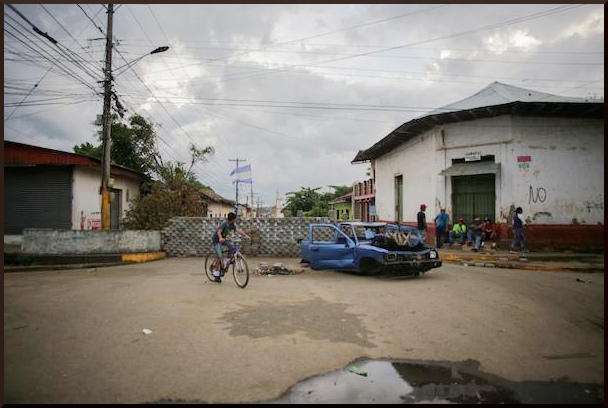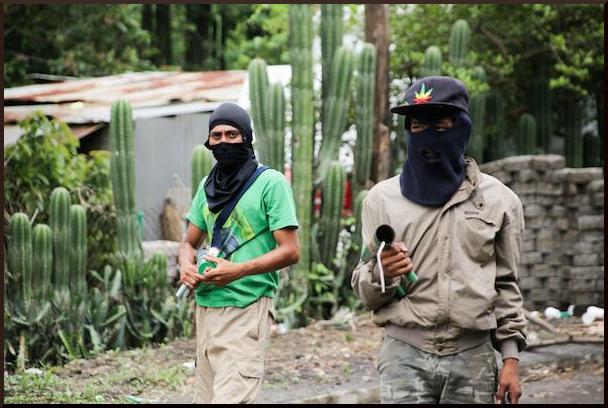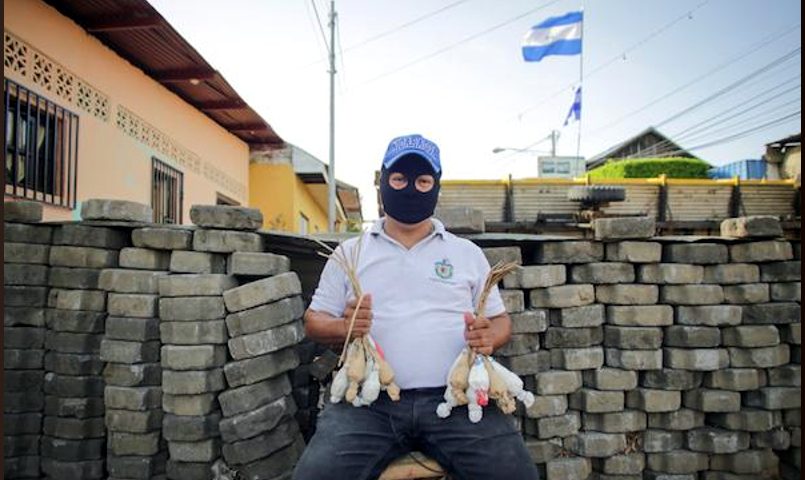In addition to students, older adults have joined the barricades and self-defense groups who block the entry of paramilitaries and anti-riot police into the city of Masaya, Nicaragua. ~Photo by Rafael Camacho
Editor’s note: The relative merits of this article and the following one have been much debated on our list serve. I am posting both here as both are worthy of consideration. The issues raised at the end of this article overlap with those highlighted in the next one, a much shorter ‘expose’ of U.S. meddling. This article is long and the introductory assertions are biased and inflammatory, so if you don’t read all the way to the end, then you will miss the point.
by Lori Hanson and Miguel Gomez, originally published on NACLA, June 15, 2018
On April 18, Nicaraguan students initiated an uprising that is redefining the country. For the first time in his 11-year presidency, President Daniel Ortega has lost control of Nicaragua’s most important political domain: the streets. Ortega’s vicious fight to take them back has relied on extreme levels of violence—and revealed a host of deep contradictions in the political life of the country.
Nicaragua is still a polarized post-war country with deep social cleavages and unhealed wounds; in many ways, April was an eruption of what festered. Yet it remains vexing how the relative peace of the past two decades could so quickly evaporate and leave 149 deaths, over a thousand wounded, and hundreds detained in its wake. Over 50 days later, the international press continues to focus on deaths, terror, assassinations, and even the existence of a so-called “sniper alley” in its most touristic locales, offsetting those accounts with stories on a now truncated and intransigent national dialogue, and declarations of vague international support. The Left must move past generalities, condemnation, and shock toward a constructive and critical analysis of the movement itself and the ideologies and strategies that comprise it. As the crisis threatens to become a war of attrition, this task grows more urgent by the day.
The Origin of the Student Movement
The current wave of protests began in early April, when university students, supported by the environmentalist movement, launched three separate national protests, calling themselves the autoconvocados, or the self-assembled or self-organized. They were initially responding to what they saw as government negligence in putting out widespread fires that had raged for over a week in the Indio Maiz biosphere (where 70% of Nicaraguan biodiversity is found), and used the hashtag #SOSIndioMaiz. As the winds changed direction, the fires came under control. At the same time, Ortega passed austerity reforms to the country’s pension fund, the Nicaraguan Social Security Institute (INSS), without consultation, and the focus quickly shifted: #SOSIndioMaiz became #SOSINSS. Students joined pensioners in protest, much as they also did in 2013 (#ocupaINSS).
As the violence deepened and protests spread, the autoconvocados movement grew from a seemingly homogeneous small group of outraged public university students to a diverse array of oppositional movements and private sector actors, each with their own political agenda. By late April, #SOSINSS had turned into an encompassing #SOSNicaragua and an unlikely alliance, known as the Alianza Cívica por la Justicia y la Democracia (Civil Alliance for Justice and Democracy), comprised of the private sector, students, select members of civil society, and social movements, had formed.

At least on the surface, the new social movement of autoconvocados seemed non-ideological, leaderless, and lacking a clear organizational structure. It relied on bottom-up, social network-based approaches to organization that challenge the rigid hierarchical, caudillo– and party-driven politics of Nicaragua. Protesters seemed moved, much like Spain’s “indignados,” by a general sense of moral outrage in the face of a corrupt and authoritarian system—not by a defined political platform. Their hope, quipped one in a recent interview in the Nicaraguan newspaper La Prensa, is a “conviction, not a certainty.”
The very name autoconvocados is powerfully symbolic: it is a constant reminder that the youth are protesting by their own free will and not because they have been asked or compelled by an umbrella organization or a leader. The reference is at least in part targeted towards the ruling party’s youth wing Juventud Sandinista (Sandinista Youth, JS) and the Union de Estudiantes Universitarios de Nicaragua (Union of University Students of Nicaragua, UNEN)—both party-led and run. The autoconvocados tag also serves as a strong rejection of “politics as usual” in Nicaragua, characterized by political pacts, private sector backroom deals, and regressive church influence.
In a recent interview for the German newspaper Deutsche Welle, Madelaine Caracas—one of the most visible faces of the autoconvocados movement—illustrated the movement’s wariness of the Nicaraguan establishment: “We trust no one,” Caracas said. “In Nicaragua there is no opposition. They are all the same. […] It is all Nicaraguans who are in the streets. It is no political party, no liberals, no conservatives, not the CIA. It is an awakening; we are tired of seeing our brothers killed.” Local groups of the autoconvocados across the country serve as a loose network to share news and coordinate civil disobedience actions.
The autoconvocados movement is essentially made up of five student groups, from the most militant—the Movimiento Estudiantil 19 De Abril (April 19th Student Movement, ME19A) and the splinter group Movimiento Universitario 19 de Abril (April 19th University Movement, MU19A)—to the Alianza Universitaria Nicaragüense (AUN), Coordinadora Universitaria por la Democracia y la Justicia (CUDJ), and students from the agrarian UNA University who have thus far remained anonymous. ME19A and MU19A are the original group of students who first occupied the campus of the Polytechnic University of Nicaragua (UPOLI) on April 19, which has become one of the strongholds of the student uprising, one of the main symbols of the peaceful resistance, and one of the bloodiest grounds of repression. Since they first occupied the UPOLI campus, these movements have also occupied the Managua campus of the national university UNAN, the agrarian university UNA, and recently, while under fire, the engineering university UNI. Beyond moral outrage, much of the specific ideologies and strategies of each of these groups remains to be seen.
The 40 or so leaders that represent the different student groups have recently begun to use the hashtag #CoaliciónUniversitaria (University Coalition) to refer to themselves as a single coalition. Its most prominent leaders are interviewed they claim not leadership, but membership in the Coalición—and many largely operate underground. The Ortega regime clearly sees them as a threat.
But tensions and contradictions among the different factions of the movement are already surfacing, particularly following a trip by three student leaders to the 48th session of the General Assembly of the Organization of American States (OAS) held last week in Washington, DC. The purpose of the trip was ostensibly for students to denounce the political crisis in Nicaragua to the OAS. But a delegation of those students later shared pictures on social media posing with Senator Marco Rubio (R-FL) and Representative Ileana Ros-Lehtinen (R-FL), who represent most conservative, right-wing and hawkish sectors of the Republican Party.
In a recent interview, self-described [?] “leftist” Harley Morales of the AUN, who did not attend, said, “There were many actors wanting to mess with the agenda from the beginning,” he said. “I’m referring to organizations, the political opposition, some farther to the right… This trip was financed from the United States [Freedom Foundation] and an agenda was imposed. [The Foundation] decided which students would go.” The Morales interview reveals not only the tensions between the different students, but also the danger that the movement’s sincere intentions to promote progressive democratic change could be coopted by some of the most regressive forces in Nicaraguan politics.
Tensions, Contradictions, and the Dangers of Ill-definition
The tensions that arose during last week’s OAS meetings bring to light the wide range of opinions—from right-wing apologists to militant leftists—coalescing behind the Nicaraguan resistance. A large contingent of the autoconvocados identify themselves as critical or former Sandinistas, or even children of the Sandinista revolution. Singing revolutionary songs and chanting slogans from the ‘70s and ‘80s like “que se rinda tu madre” (“let your mother surrender”)—the war cry of Sandinista poet and revolutionary Leonel Rugama who died in 1970 battling the National Guard under dictator Anastasio Somoza—has become a signature of those who long for the past and the unfinished revolution. It is ironic that the very same people that burn Sandinista flags now since these once-revolutionary tunes.
Yet not everyone who supports the movement shares this revolutionary nostalgia. In fact, many in the movement and the civic alliance are fervent anti-Sandinistas. These are people who do not just oppose Ortega and Murillo in the current context but also pro-capitalists who have attacked the Sandinistas since their emergence. This group includes Somocistas (those who defend the legacy of the Somoza dictatorship), Liberals, Conservatives, and former Contras. There is growing evidence that from the ranks of anti-Sandinistas such groups are arming themselves and gaining momentum.
Meanwhile, labor unions —government-sponsored or otherwise—appear to have little sway in the movement, though human rights organizations like the Nicaraguan Center for Human Rights (CENIDH) and the Maria Elena Cuadra maquila network claim to represent the interests of workers and women in the larger alliance and national dialogue. Some members of the private sector, who claim to represent the interests not only of capital interests but also labor, have called for a National Strike.
Further, representation of peasants and farmers, who make up over 40% of Nicaragua’s population, is incomplete. While some farmers are involved in a movement against a proposed trans-oceanic canal through Nicaragua, this group has little connection to the much larger northern and northwestern agricultural parts of the country and the demands of campesinos living there. So, it is unclear where farmers and other rural sectors might fall in the context of thie national movement.
Is Nicaragua in the midst of a revolution? If so, what kind of revolution is it? Some prominent figures in the student Coalición have deemed it so—and a few have gone so far as to call it feminist. But ties to women’s demands in such an ideological soup seem far-fetched in light of the rampant machismo of some of the movement’s leaders. For example, Lesther Alemán, the student leader who called Ortega an “assassin” during the first day of the televised National Dialogue, revealed his “two dreams” in an interview with The New York Times: to join the army (“because he loves order and seriousness and camouflaged uniforms”) and to become president. “That’s why the only pseudonym I allow you to call me is Comandante,” he added. Debates on social media about ‘Comandante’ that followed suggests that caudillismo is alive and well as a movement tactic.
When asked about the Times’ interview in La Prensa, Enrieth Martinez, another prominent student leader, sloughed off the obvious contradiction between Lesther’s comments and the feminist claims within the movement, saying: “It is quite naive to think that living in a country with such a vertical political culture, so sexist, so racist, that these things will diminish…Our society works because it is sexist, because it is racist, and because it is capitalist. And classist too. Expressions of micromachismos are apparent.”
Mexican social commentator Gema Espinoza is more direct in her analysis of the movement. She argues that “the political dialogue is primarily between men,” and the most visible manifestation of women is that of the “mothers of the young men killed by the regime.” She writes: “While publications are being shared [on social media] about the importance of being feminists…femicides continue, the lack of representation of women of all classes and races continues and the problem of inequality is more present than ever.” But she adds, “this is an opportunity to reinvent ourselves and stop living from the discourse to live from the action.”
Indeed, the protests have a strong nationalist character—the blue and white flag of Nicaragua being ubiquitous in the marches—where demonstrators clamor for justice and democracy, without clearly defining what they mean by those terms.
A recent Gallup poll, which found that 63% of Nicaraguans want Ortega out of power, also reflects the wide ideological range that makes up opposition to Ortega. Yet, according to the poll, the most trusted public figure in the country is Cardinal Leopoldo Brenes, moderator of the national dialogue that has gone on it fits and starts since April, followed by Silvio José Báez, the progressive Auxiliary Bishop of Managua, and Carlos Pellas, Nicaragua’s most preeminent business magnate and first billionaire. So while students assert this as a revolutionary struggle against the old regime of power, the three most respected people in the country are Catholic bishops and Nicaragua’s richest man
A De-Articulated Politics
The phenomenon of decentralized, social network-based, and horizontal social movements calling for justice and democracy is nothing new. In 2011, thousands of Egyptians joined the protests at Tahrir Square in what came to be known as the Arab Spring. Some pundits have even termed the current Nicaraguan uprising as the “Nicaraguan Spring,” alluding to the Middle East. The Egyptian movement was successful in forcing the resignation of President Hosni Mubarak, but it did not succeed in transforming the political system—in part because no viable political platform had been developed.
If a social movement can be broadly defined as the self-organization and collective action of a network of individuals or groups that share a common goal and demand social or political change then, at the present moment, the only element holding the movement and its supporters together seems to be the opposition to Ortega. Perilously, the whole edifice of the movement seems to be hanging by a single thread.

The autoconvocados have bravely defined themselves as a political force in Nicaragua and put their bodies on the line. But if they are to radically transform the political landscape, they will need to strategize to fight the government in ways that do not play into the hands of the national right wing or ideological potpourris. They must also name and confront the current contradictions within their ranks.
The autoconvocado uprising was a much-needed empowering act for a generation of youth that have been disenfranchised and disillusioned with a government that has clung to power for far too long. But the political interests of the capitalist class have always used popular protest and crises for their own means. The right wing that represents the capitalist class in Nicaragua, and their counterparts in the United States, Canada, and elsewhere is ever-ready to pounce on the economic opportunities that the crisis has opened. And the most reactionary of these groups is ever-ready and arming itself to help. The unfortunate reality of popular uprisings is that there is much more to do than just hitting the streets.
As time passes, the movement leaders who initiated the change will need to find and define a political platform or risk getting absorbed by the politics and patriarchal norms of capitalist opportunists eager to offer it a direction. The Left and alternative press passes up on a unique opportunity for change in offering vague supports for a movement so ill-defined. This uprising is an opportunity for change, but that change must be defined—and critiqued—by those most affected.
Lori Hanson is a professor at the University of Saskatchewan and a long-time Nicaragua solidarity activist working primarily with women’s and rural anti-mining movements.
Miguel Gomez is a Nicaraguan environmental and social justice activist and professor of political economy at the Universidad Americana.
